2023 Hyundai Tucson Review: Great hybrids, wild style, big space

Pros: All-star hybrid powertrain; excellent tech; huge cargo area; high-quality cabin
Cons: Sad sack base engine; some weird interior controls; a bit blah to drive
You have to give the designers of the 2023 Hyundai Tucson credit: They really went for it. In a segment long known for bland anonymity, the Tucson is an explosion of sharp creases, odd bulges and a smiling grille that lights up on its edges like a Vegas marquee. The wheel arches are angular rather than actual arches, there are diamond shapes embossed in the rear bumper, and LED taillights that dangle from a full-width light bar like Dracula fangs. There’s A LOT going on. Maybe too much, but hey, better than dull.
And, importantly, all of the above adorns a solid entry in the ultra-competitive compact SUV segment. It’s really big, for one, besting the cargo capacity of the Toyota RAV4 and last-gen CR-V, and offering similar passenger-hauling capability. It has a nicer interior than both, too, with much better infotainment and safety technology. The Tucson Hybrid’s powertrain is also an all-star, uniquely combining a turbocharged engine, electric motor and six-speed automatic to create a powertrain that is surprisingly powerful and refined, thrifty as expected, and pleasingly normal to drive. The Tucson Plug-In Hybrid steps all that up even further. Unfortunately, the base engine is a real slug, and worse, is the only way to get the more characterful N Line and XRT trim levels. We’d likely choose another compact SUV over a gas-only Tucson, but the Hybrid? Definitely check that out. And if A LOT is not what you’re going for stylistically, the 2023 Kia Sportage is mechanically related.
Interior & Technology | Passenger & Cargo Space | Performance & Fuel Economy
What it's like to drive | Pricing & Trim Levels | Crash Ratings & Safety Features
What's new for 2023?
Forward collision warning and adaptive cruise control with stop-and-go capability are now standard on every trim level, while all but the base trim now comes standard with a hands-free liftgate and wireless device charging. This is also the first full model year for the plug-in hybrid, the sportier Tucson N Line and the more rugged Tucson XRT.
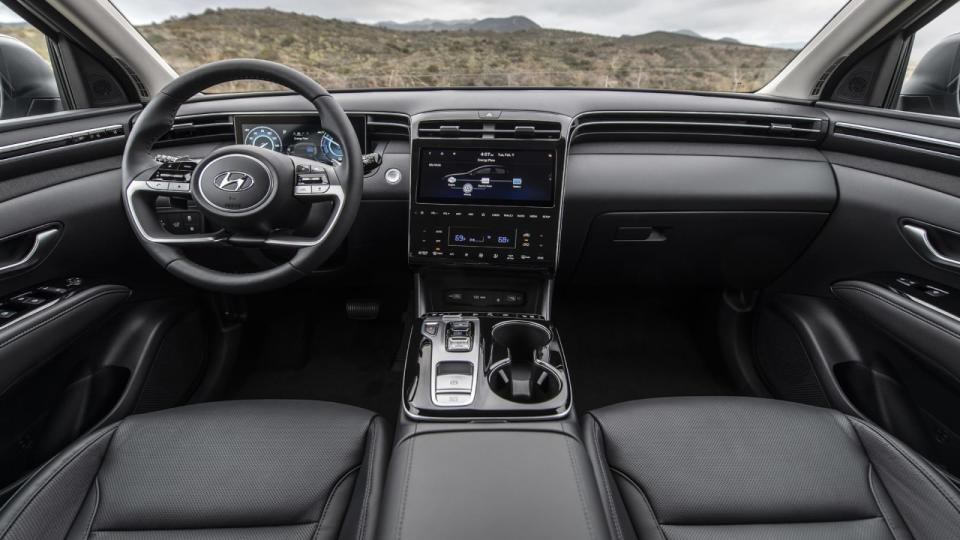
What are the Tucson interior and in-car technology like?
In a segment where many competitors go with a more functional aesthetic, the Hyundai Tucson is more stylish, more tech-focused and more premium. We especially like the dash-width vents and cloth trim. Plastics and switchgear are of a high quality as well. There are some key differences based on trim level, however. Besides upholstery and color choices, the center stack controls actually differ. The SE and SEL come with an 8-inch touchscreen, while an upgrade 10.25-inch widescreen unit is standard on everything else (plus the SEL’s Convenience package). Their basic user interface is similar, but the bigger screen increases functionality. Unusually, only the 8-inch screen is compatible with wireless Android Auto and Apple CarPlay; the larger unit requires a wired connection. This is true of most recent Hyundai products, and the 10.25-inch system will get new hardware in future model years to address this.
With either, Hyundai ditched a traditional volume knob and other physical controls, which is a downgrade. The 8-inch screen is paired scroll wheels for volume and tuning (below left), which is technically better than the tap-tap-tapping you have to do with the all-touch controls paired with the 10.25-inch unit (below right), but they're still strange. Touch-sensitive controls have also historically been difficult to find and successfully press while driving, and these are no different. All that piano black trim also means lots and lots of fingerprints.
Otherwise, the front seats are comfortable and supportive with excellent adjustment on higher trims (base models get just six-way manual adjustment). Rear-seat recline and remote fold-down features are standard, and heating for the rear bench is available on the range-topping Limited model.
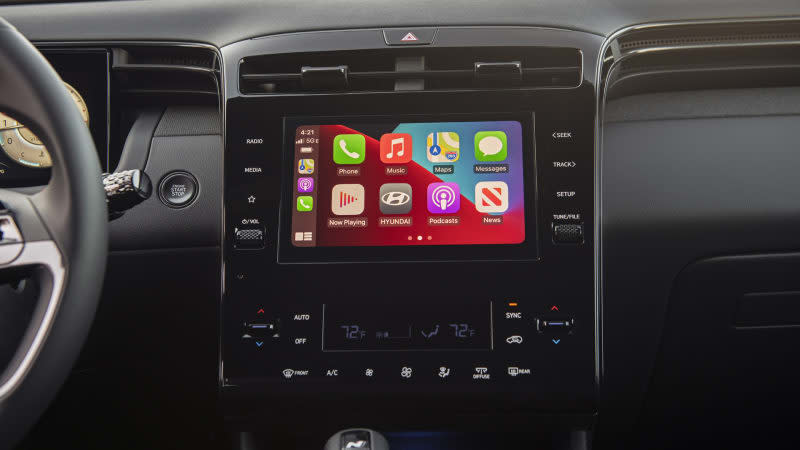
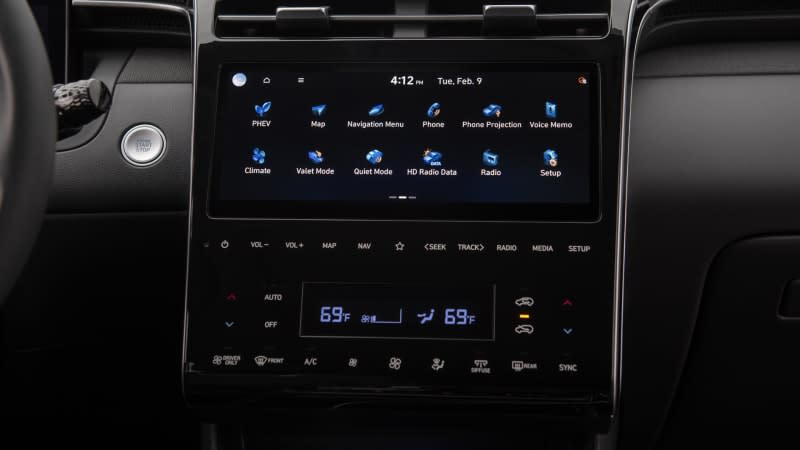
How big is the Tucson?
For something dubbed a “compact SUV,” the answer is “very big.” With a little help from its new, larger platform, the Tucson grew considerably inside for the 2022 model year. It’s now almost exactly the same size as a Toyota RAV4, Honda CR-V and its mechanically related Kia Sportage cousin, making it one of the largest in the segment. Besides offering plenty of room for adults, we could easily fit a rear-facing child seat while maintaining plenty of space up front for driver and passenger.
Behind the raised back seat, Hyundai now claims 38.7 cubic feet of rear cargo room, which puts it right between the Honda CR-V and Toyota RAV4. At least on paper. As we discovered in our Tucson luggage test, the new Tucson can actually hold a bit more than them when it comes to actual stuff. There is an asterisk, though. Although the Tucson Hybrid has the same cargo capacity on paper as the gas-only version, it does not have a spare tire (like the CR-V Hybrid, but unlike the RAV4 Hybrid). So, you do lose something by adding batteries -- it's just not obvious on the spec sheet or when loading bags.
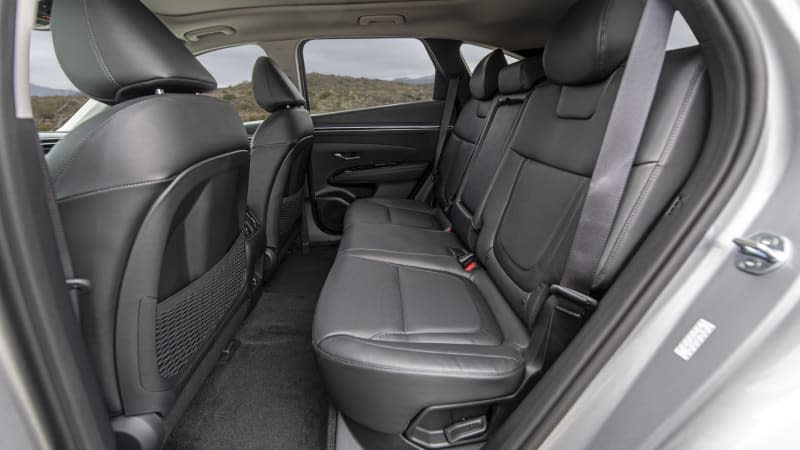
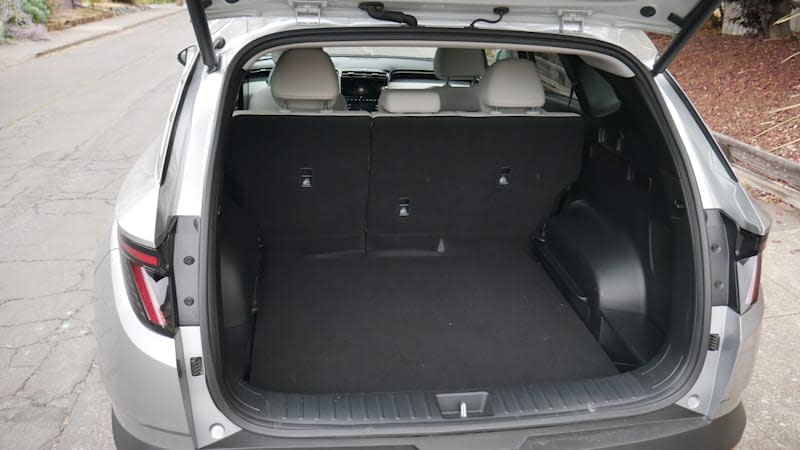
What are the Tucson fuel economy and performance specs?
The Tucson comes standard with a 2.5-liter inline-four that produces an adequate but uninspiring 187 horsepower and 178 pound-feet of torque. Acceleration tests from various publications have shown a 0-60 “sprint” takes more than 9 seconds, making it one of the slowest vehicles in the segment. EPA fuel economy estimates for 2023 were not available at the time of this writing for any Tucson, but it’s unlikely they would change substantially from their final 2022 estimates. Those were 26 mpg city, 33 mpg highway and 29 mpg combined with standard front-wheel drive and 24/29/26 mpg with optional all-wheel drive.
The 2023 Hyundai Tucson Hybrid is a substantially better choice than the base engine as it represents both a fuel economy and performance upgrade. Its combination of 1.6-liter turbocharged inline-four, electric motor and six-speed automatic transmission produces a total output of 226 hp and 258 lb-ft of torque. That’s a huge jump and one you’ll notice behind the wheel. All-wheel drive is standard, and unlike the Toyota RAV4, it is an actual mechanical AWD system rather than a “through-the-road” system that uses an additional electric motor to power the rear wheels. Last year’s fuel economy estimates were 37 mpg city, 36 mpg highway and 37 mpg combined or 38/38/38 for the base Tucson Hybrid Blue trim level.
The Tucson Plug-In Hybrid basically adds a substantially larger battery pack and a more powerful electric motor to the Tucson Hybrid powertrain. This results in an increase to 261 hp and the same 258 lb-ft of torque, but also allows for 33 miles of all-electric range and a rating of 80 MPG-e from the EPA. That isn’t quite as thrifty as the Toyota RAV4 Prime and Ford Escape PHEV, but if your commute and daily errands fall within that 33 miles (a strong possibility), you’re still going to be rarely filling up.
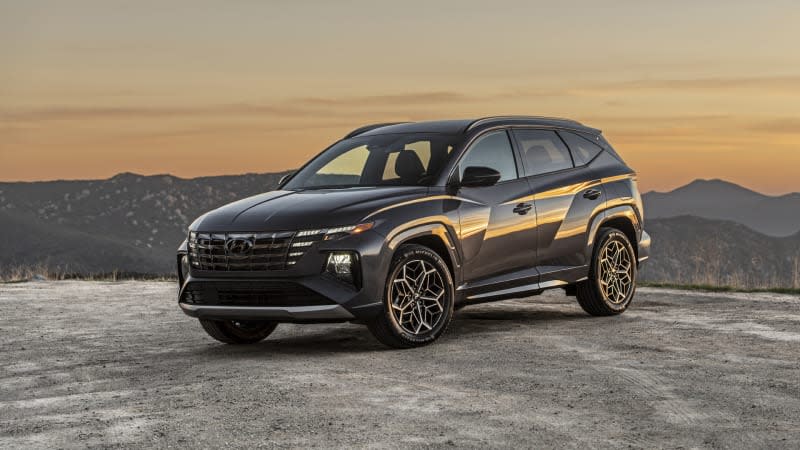
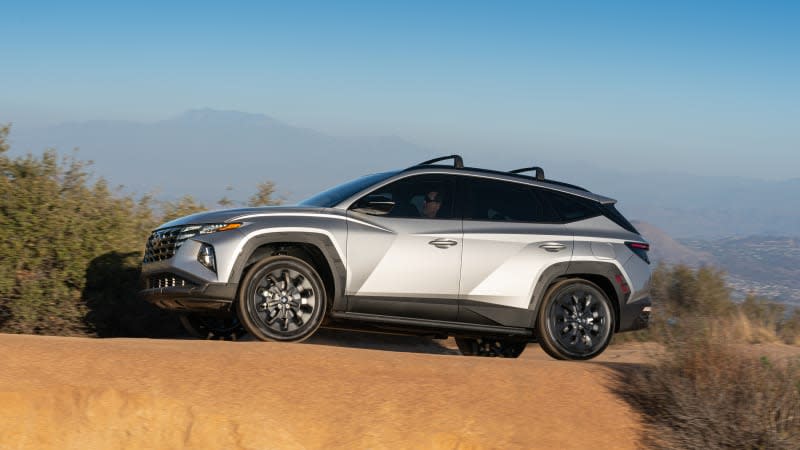

 Yahoo Autos
Yahoo Autos 
